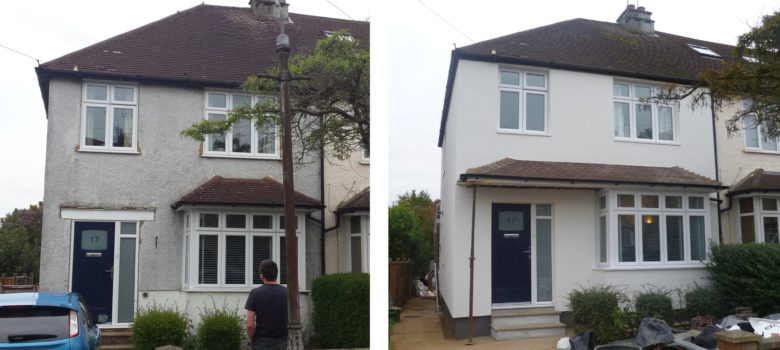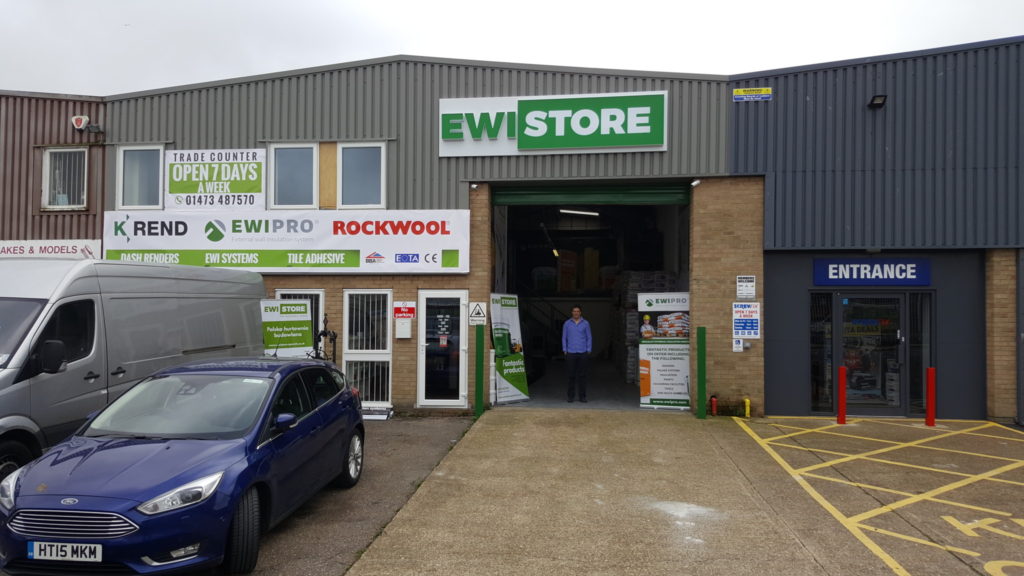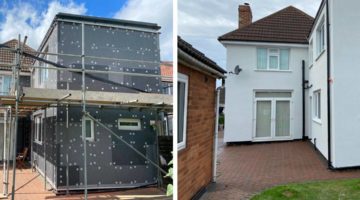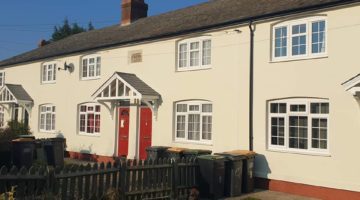
Essex is in large part a ‘rural’ county, with the urban sprawl concentrated around the Thames Estuary towns of Thurrock and Basildon, and larger towns away from the Greater London Metropolitan areas such as Colchester and Chelmsford. The common construction of properties is your traditional ‘bricks and mortar’, with more modern developments taking place after the War to help with population movements and expansion of the commuter belt who rely on London for work.
We have covered the full breadth and depth of Essex (as well as East England & Suffolk) during some of our external wall insulation projects over the years, and hopefully this blog will be of interest as we discuss ways homes can be made warmer by investing for the long-term and the future.
What is the typical property construction type in Essex?
Properties were largely constructed before the Second World War (excluding the new towns) using traditional materials (straw, stone and brick). A large proportion of those properties are solid construction (so a single skin of brick, 220mm to 250mm thick) with some plastering internally and very likely traditional brick look on the outside with some properties also having rendering put on 20-30 years ago.
If you drive through Epping Forest and areas of Brentwood districts, in the older parts of the town/s you will notice rows of old terraced homes. These were built during the Victorian or early Edwardian periods and have typical features, such as decorative (Victorian) or squared-off (Edwardian) bays at the front. These houses are also common in the small parish villages and in the older parts of Colchester and Chelmsford.
In the 1930s, there was a move to expansion from the ‘industrialised’ central parts of towns into the more spacious suburbs. This brought the semi-detached property that you see commonly, with large circular bays (and sometimes decorative tiles at the top) – a type of property built for families at the time.
These property types have the common solid brick construction, and if you look across our site you will see have countless examples of projects that are examples of external wall insulation retrofit. Local contractors in the process tell us that some houses are a lot trickier to insulate than others, so be prepared for varying costs depending on the difficulty of the project.
We have also surveyed and energy assessed properties built from the 1950s onwards in the new towns (Thurrock and Basildon). These were built with cavity walls (270mm to 310mm thick), with an air gap in the middle of two layers of brick, or thermal block with brick on the outside. Although previous government schemes targeted cavity wall insulation for these properties, we have found external wall insulation to be a much better and longer lasting solution. In some of the cases we have further enhanced the existing cavity wall insulation with additional external wall insulation.
Why is there a need to bring many properties in Essex to modern energy efficiency standards?
Essentially, the older housing stock (while solidly built) tends to leak energy left, right and centre. This is not only wasteful to the occupier, leading to high heating bills, but is also not great for the overall comfort with all those draughts over the cold winter months.
The most recent MP Infrastructure Report has stated that energy bills will rise by the end of the decade. On top of the risks they consider, there could be unreported rises due to rising infrastructure upgrade costs and the potential volatility of supply of core fuels like oil and gas. The best one can do is to prepare for the uncertainty and control consumption levels – not by turning off the hot water or turning the heating off, but learning not to waste energy, while staying comfortable and warm. This is what we call energy efficiency and should be made easier by tackling the highest energy impact areas of the property, which are the walls and the roof space.
Just insulating the walls of the property can save up to 40% of total energy losses on a typical British home. If you live in a semi-detached or a detached home, with the exposed flank walls, the impact of retrofit insulation will have the greatest impact!
What is external wall insulation?
In essence, external wall insulation is like providing a warm blanket around the walls of a house. First an insulating material like EPS or mineral wool is wrapped around the walls, then the outer layers are sealed with flexible beading and a high quality, breathable render product.
Of course, there are many ways to carry out the external wall insulating process, and sometimes choosing between systems can feel like a minefield, but the majority are produced and installed on the same principles.
The external wall insulation also has three additional benefits over internal insulation:
- Protecting the outer leaf of the property from driving moisture and rainfall;
- Reducing the risk of future interstitial condensation (also known as trapped moisture within the fabric of the walls);
- Providing the outer part of the property with a completely new look (especially vs. existing, tired render).
Are there any grants now in Essex for External Wall Insulation?
Previously, there were some very generous grants via the Green Deal Home Improvement Fund scheme, but unfortunately those funding mechanisms are long gone and they will not come back any time soon, based on the current government’s signals about industry priorities.
Given that external wall insulation is a fairly pricey measure (compared to cavity wall insulation) – typically costs start from £95m2 and can go up to £130m2 depending on the materials and work required to bring the property up to a modern energy standard.
Our quotations are for the whole works – property preparation, scaffolding, the insulation works and post-completion clean-up.
Additional benefits of external wall insulation in Essex
If you do reside in a period property somewhere in Essex, then there are additional benefits that can be realised by carrying out a retrofit project. Rather than looking at the cost of the measure, see it as an investment opportunity that can bring about both short-term and long-term benefits.
You may have moved out ‘to the sticks’ to a bigger property and you want to make it as comfortable as possible for the ever expanding family. So, consider external wall insulation in the middle of a retrofit project that will take place anyway, such as a typical loft extension, side return and so forth. The works generally require scaffolding being erected and being up for weeks until the works are complete.
Scaffolding is a large component of the fixed costs of external wall insulation, and therefore rather than doing everything else in isolation OR instead of just slapping some render to the existing part of the house, why not combine the projects. Insulate the whole house and realise short-term savings already by using the scaffolding that is already there, taking money off the external wall insulation quote.
The county of Essex has some fantastic schools (primary and secondary) both in the government and independent sectors, and therefore a lot of decisions about moving away from the urban parts of London to rural parts or small towns in Essex are determined by the proximity of the properties to local schools. However, living in an energy inefficient property becomes quite a shock after a couple of winters, being uncomfortable and costing an arm and a leg to run.
Retrofit external wall insulation that involves the addition of 100mm of external insulation can reduce the U-value of solid wall from 2.1W/m2K to 0.28 W/m2K or better. This is a very significant improvement and prevents heat movement from the inside to the outside. You could also afford to turn the heating off for longer periods without the property losing heat.
Analysing some EPC data at our disposal (over the last 4 years) and looking at the GreenAge+ specialist surveys carried on typical properties in the Essex area, we have come up with a simplified table showing the existing running costs of properties with poor insulation and then some of the savings that can be realised from external wall insulation retrofit on those properties:
| Property type | Estimated Energy Costs (gas & electricity) | Estimated annual savings with EWI |
| Mid-terrace | £1,649 | £131 |
| Semi-detached | £2,049 | £308 |
| Detached | £2,370 | £472 |
Assumptions:
1. Using EPC data for typical properties in the Essex area.
2. Property scaling: 90m2 area property with partial double glazing, 75mm of loft insulation and a non-condensing boiler.
You may well be a Landlord or planning to purchase an investment property on a buy-to-let deal, but did you know that from 2018, all rented properties in the UK will be subject to more stringent regulations around energy efficiency? Therefore, if you rent out at the moment, why wait to be fined? Take proactive action now to improve your existing housing stock, that will not only help with compliance, but will give your tenant much better conditions to live in. Another short-term benefit realised.
There are many busy urban roads all round Essex, but if you are like many other people, you may live off an extremely fast-moving country or A road. It can be annoying having to put up with all that noise pollution. Another benefit of external wall insulation, particularly mineral wool, is that it is not only a heat insulator, but also great for overall acoustic reduction. Another fantastic short-term, medium-term and long-term benefit.
Improving your external walls with flexible render and insulation systems will put us on par with many Nordic European countries, which to be honest are slightly ahead of the game when it comes to having overall good quality energy efficient housing. While this work is still going on, the installer should also have a look at the guttering, roof and the loft space – suggesting improvements and repairs if appropriate.
For example, speaking to local installers, when the external wall insulation is carried out, they also inspect the eaves and loft space, ensuring there is plenty of insulation to reduce the effects of thermal bridging on top of the walls.
Retrofit loft insulation is relatively inexpensive, and this is one of the elements you can ask your installer to look at, as reducing energy consumption by a further 25% is well worth it.
Finally, dare we say it, let’s also mention increasing property values with improved energy efficiency and external insulation…
A government study (by BEIS, previously DECC), took place a few years ago (see here), which looked at various data in different regions of the country, and impact of increasing energy efficiency retrofit to house price rises. While there is currently a moderate link between the two elements, you can conclude that with landlord regulations coming in and more of the public becoming aware of the need to keep properties comfortable and low-cost to run, the relationship can only get stronger in the longer term.
As you can see, while in the short-run there is a sizeable upfront cost to the measure, the benefits you can realise over the long-run make the measure well worth exploring.
How do I go about learning more about external wall insulation?
We are extremely thankful to EWI Store, Ipswich, who are a specialist external wall insulation materials supplier in the Sussex/Essex area. They took us round their facilities and showed us some of these possibilities with external wall insulation, and some of the finishes that customers can go for to improve their properties.
As part of their training, they helped carry out a demonstration on how to insulate an external wall, right from handling the materials to actually putting them up on the walls.
Michael, Store Manager at EWIStore Ipswich says: “we have specifically set-up shop in the East of England to potentially help 1,000s of homeowners, private developers and specialist EWI contractors realise their ambition of retrofitting their homes and businesses with external wall insulation and specialist rendering products.
You can come to our store as we are open 8am to 6pm Monday to Saturdays, and ask me and my guys any questions about these products. Come if you just want a quick look or just simply touch the products for your own benefit. For specialist contractors, we have colour mixing facilities on-site (no waiting times for coloured render), different types of renders (to suit different climates) and even brick slips, that can imitate the look and feel of actual bricks.”

In addition, we are very thankful to some local contractors who took us around various jobs they undertook, installing external wall insulation in the Essex area. This, combined with the drop-in session at EWI Store, has helped us put together this local based research.
Can I organise a quote for external wall insulation if I live in and about the Essex area?
Since 2014, we have been working in close collaboration with EWI Pro Insulation Systems, who are a specialist external wall insulation manufacturer and BBA-approved system certificate holder. We have been very fortunate over the years to have a link to their installer network, which has allowed us to work together on projects, or simply use our knowledge of the various fitters in different areas who do this type of work.
If you will us to help you organise a quotation for potential external insulation works in the Essex, East London, or east Suffolk areas, then do not hesitate to get in touch.
We also encourage you (time permitting), to go and have a look at the products available at EWI Store, Ipswich and learn more about the install process, which can actually take 2-3 weeks on a typical house.













Thanks, a very helpful article.
Thanks Mic, if you are looking to get solid wall insulation installed in Essex please do give us a shout since we have installers in your area.
Any installers around Colchester you know? Looking to do external claddind to front and side
Hi Owen, we do have a few installers in Essex, but in terms of Colchester they are a little thin on the ground. Most installers will be willing to travel though from East London over…
External wall insulation quote
Is there any government grants or funding available I have solid walls I need help my home is very cold in the winter I have been laid off work sick if you can suggest anything please could you email me Satnam Singh
Hi Satnam, there is a small amount of funding available via a scheme known as ECO (or the Energy Company Obligation). This tends to cover about 1/10th of the cost of the works, so if the external wall insulation costs £10,000 to install, you would receive a grant of £1,000 towards this. Sorry there is nothing more to help!
Hy,I will like to the exterior insulation to my house,is real the price of 130£ m/square ,is coming with any warranty!how i can get a quote?post code is rm15,
Kind regards Andrei Buf
I would very much like to learn the installation processes and find work with a local company. Any ideas on this, please.